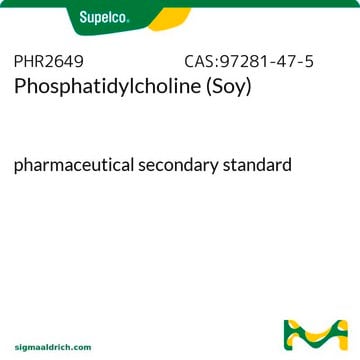SMB00611
1,2-Dilauroyl-sn-glycero-3-phosphorylglycerol sodium salt
≥98%
Synonym(s):
1,2-Didodecanoyl-sn-glycero-3-phosphorylglycerol sodium, 1-[[[(2,3-Dihydroxypropoxy)hydroxyphosphinyl]oxy]methyl]-1,2-ethanediyl ester-dodecanoic acid sodium
About This Item
Recommended Products
assay
≥98%
form
powder
functional group
carboxylic acid
lipid type
phosphoglycerides
shipped in
wet ice
storage temp.
−20°C
InChI
1S/C30H59O10P.Na/c1-3-5-7-9-11-13-15-17-19-21-29(33)37-25-28(26-39-41(35,36)38-24-27(32)23-31)40-30(34)22-20-18-16-14-12-10-8-6-4-2;/h27-28,31-32H,3-26H2,1-2H3,(H,35,36);/q;+1/p-1/t27-,28+;/m0./s1
InChI key
CIRSYGHBBDDURM-DUZWKJOOSA-M
Biochem/physiol Actions
Phosphatidylglycerols are used in in silico studies of model membranes. Under specific experimental conditions, they exhibit similar phase transition properties as zwitterionic phosphatidylcholines. Lipid-based particle drug delivery studies using dispersions of dilauroylphosphatidylethanolamine (DLPE) and dilauroylphosphatidylglycerol (DLPG) have been shown to exhibit a metastable state which allows for the manipulation of delayed nucleation; thus providing new avenues in the design of novel modalities for the drug delivery of therapeutic payloads.
Storage Class
11 - Combustible Solids
wgk_germany
WGK 3
flash_point_f
Not applicable
flash_point_c
Not applicable
Certificates of Analysis (COA)
Search for Certificates of Analysis (COA) by entering the products Lot/Batch Number. Lot and Batch Numbers can be found on a product’s label following the words ‘Lot’ or ‘Batch’.
Already Own This Product?
Find documentation for the products that you have recently purchased in the Document Library.
Our team of scientists has experience in all areas of research including Life Science, Material Science, Chemical Synthesis, Chromatography, Analytical and many others.
Contact Technical Service








